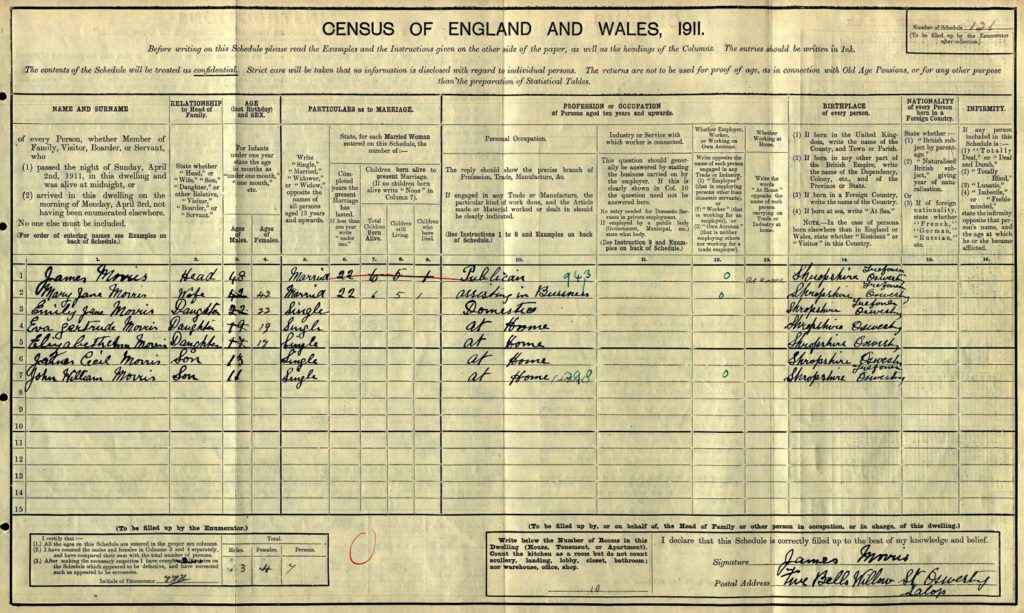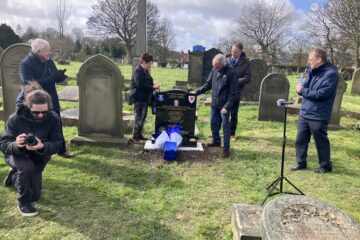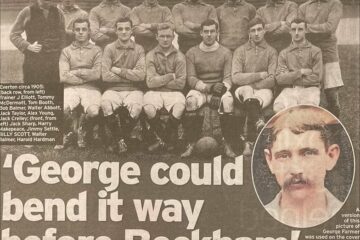The Welsh Marches village of Trefonen in Shropshire was the birthplace of James Morris in April 1863, the third child of Anne and her Welsh husband, Robert. James made a most unusual appearance for Everton during their first season as members of the Football League.
According to the 1881 census, the family were living in Oswestry, and James was working along with his father as a brickmaker. He began his football career with an Oswestry club who were founder members of the Shropshire FA in 1879. They shared a ground with the local cricket club at Victoria Road and lifted the Welsh & Border Counties FA Cup in 1884 by defeating Druids. They followed up their success by winning the Shropshire Senior Cup a year later, beating St Georges on Monksmoor Racecourse at Shrewsbury.
Jimmy Morris had established a place in the Oswestry team, but finished on the losing side in a 0-2 defeat against Everton on 13 March 1886. The following season, Morris had a busy time in cup competitions with Oswestry as they participated in the FA Cup, losing 3-0 away to Stoke in the third round, followed by elimination from the Welsh & Borders knockout cup. On 21 March 1887, he won his only international cap when he represented Wales in a game against Scotland at the Racecourse Ground in Wrexham, where a crowd of around 4,000 watched the visitors win 2-0. He was a member of the Oswestry club that were part of the Shropshire Football League when it was founded in August 1888.
In December 1888, his form secured a trial with Everton, as reported in the Wellington Journal:
‘The Shropshire lad made his debut on 8 December, against Long Eaton Rangers at Anfield, where he was asked to play in the centre of the forward line. He got off to a good start by scoring with almost his first kick of the game, as Everton went on to win 3-1.’
Wellington Journal, December 1888
Morris then had a double dose of what the conditions could be like for football fans who lived in the The Potteries region of North Staffordshire. On the following Monday, the Everton party arrived at Cobridge Athletic Stadium for a game against Burslam Port Vale who were members of the Combination. They found the landscape to be dominated by hundreds of bottle kiln ovens, which emitted an acrid, black smoke which restricted the daylight. This gloomy prospect was further compounded by a damp mist which covered the ground, making it almost impossible for spectators to witness all aspects of the game. Nevertheless, Jimmy Morris scored one of the goals for Everton in a 2-2 draw.
The following Saturday, 15 December, he made his Football League debut at Stoke. The weather conditions had not improved when Everton arrived at the Victoria Ground and this kept the attendance down to around 2,000 fans. It was the fourteenth league game played by Everton, by which time they had scored fifteen goals and conceded twenty-eight. Morris played at centre-forward and was the sixth player to have filled the position since the start of the season.
The visitors lost the services of Tommy Costley who was injured after fifteen minutes and never played football for Everton again. Morris then missed a couple of good chances to put the visitors ahead leaving the game goalless, a fact not unnoticed by the visiting journalist of the Football Field:
‘No goals were scored during the first half and, as the play changed direction, the weather conditions continued to deteriorate till darkness covered the ground. Seventy minutes had been played, and no goals had been scored, when the referee blew his whistle and declared the game to be a draw.’
Football Field, December 1888
The FA Committee accepted his decision and the match, amazingly, was not replayed. The Athletic News expressed sympathy for the visitors:
‘After the experience of the past week, I imagine that the Everton team will have a very poor opinion of the Potteries as a pleasant place to be. On Monday they visited Burslam to play Port Vale and the game took place in weather which was really unfit for football. The fog was so dense that the players were barely distinguishable, and it was impossible to say with certainty who scored the goals. Port Vale managed to make a draw with the Liverpool team and on Saturday I expected to see a great number of spectators present to witness the game at Stoke. The weather was, however, worse even than Monday and a much smaller number of spectators than usual attended the game.’
Athletic News, 18 December 1888.

The Everton executive did not select Morris to play again, and it is fair to say that their treatment of him was slightly unfair. To expect a player, who was principally a half-back, to solve the club’s goal scoring problems was perhaps asking a little too much without some time to adjust.
He returned to play football in Oswestry, where he later married Mary Jane Davies and began to raise a family. In 1901, census records showed them living in Sheffield, but by 1911 they had returned to Oswestry and were running the Five Bells Tavern in Willow Street (below). James Morris was living there when he died on 15 July 1915. He was buried in Oswestry Cemetery.




